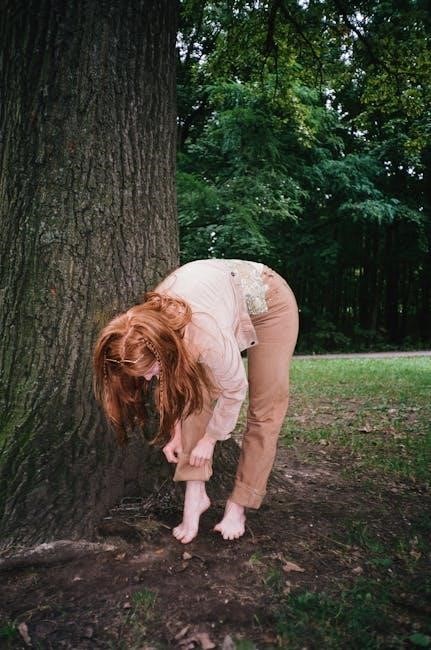
barefoot in the park pdf
Grab your free PDF copy of Neil Simon\’s “Barefoot in the Park”! Download now and dive into the classic comedy.
Barefoot in the Park, a timeless romantic comedy by Neil Simon, explores the challenges of marriage through the adventures of newlyweds Corie and Paul Bratter. Set in a charming yet chaotic Greenwich Village apartment, the play balances humor with poignant insights into love and compromise. Its themes of spontaneity versus practicality continue to resonate, making it a beloved classic in both stage and PDF formats.
Overview of the Play
Barefoot in the Park is a romantic comedy by Neil Simon that follows the journey of newlyweds Corie and Paul Bratter as they navigate the challenges of married life. Set in a small Greenwich Village apartment, the play explores their contrasting personalities—Corie’s free-spirited nature and Paul’s practicality. The story unfolds with humor and heart, highlighting their struggles to balance spontaneity with responsibility. Supporting characters like Victor Velasco and Mrs. Banks add depth and comedy, while the play’s lighthearted tone and relatable themes make it a timeless classic, both on stage and in its PDF format.
Significance of the Title
The title Barefoot in the Park symbolizes the carefree and adventurous spirit of Corie Bratter, who longs to walk barefoot in Washington Square Park. This imagery reflects her desire for spontaneity and freedom, contrasting with Paul’s practical nature. The title encapsulates the central theme of balancing responsibility with joy, highlighting the play’s exploration of marital compromise and personal growth. Its simplicity and vivid imagery make it a memorable and enduring symbol of the play’s essence, resonating with audiences in both stage productions and PDF formats of the script.
Historical Context of the Play
Barefoot in the Park, written by Neil Simon, premiered in 1963, capturing the cultural shifts of the early 1960s. Set against the backdrop of changing societal norms, the play reflects the era’s evolving views on marriage, gender roles, and personal freedom. The story of Corie and Paul Bratter, newlyweds navigating love and compromise, resonated with audiences amid the rise of counterculture movements. The play’s lighthearted yet insightful portrayal of marital challenges and generational differences struck a chord, making it a landmark of American theater during a transformative period in history.

Background of the Playwright: Neil Simon
Neil Simon, born Marvin Neil Simon in 1927, was a celebrated American playwright and screenwriter. He began his career in television writing before transitioning to theater, earning acclaim for his witty comedies that explored family dynamics and marital relationships. Known for works like The Odd Couple and Barefoot in the Park, Simon became a master of comedic dialogue, winning numerous awards, including a Pulitzer Prize in 1991 for Lost in Yonkers.

Neil Simon’s Contributions to Theater
Neil Simon revolutionized American theater with his witty dialogue and relatable portrayals of everyday life. His plays, such as Barefoot in the Park and The Odd Couple, masterfully blend comedy with poignant insights into family dynamics and marital relationships. Simon’s work often explores themes of love, compromise, and the human condition, resonating with audiences across generations. His contributions include a Pulitzer Prize for Lost in Yonkers and a legacy of shaping modern comedy. His plays remain widely performed, adapting seamlessly to stage and screen, solidifying his impact on the world of theater and beyond.
His Writing Style and Themes

Neil Simon’s writing style is characterized by sharp, dialogue-driven storytelling that blends humor with emotional depth. His plays often explore themes of love, family, and identity, with characters navigating everyday struggles and comedic misadventures. In Barefoot in the Park, Simon masterfully juxtaposes spontaneity with practicality, creating relatable tension between free-spirited Corie and pragmatic Paul. His ability to craft characters that resonate with universal human experiences has made his work timeless. Simon’s themes of relationships, compromise, and personal growth continue to captivate audiences, showcasing his genius in balancing comedy with heartfelt insight into the human condition.
Key Works and Legacy
Neil Simon’s extensive body of work includes iconic plays like The Odd Couple and Plaza Suite, cementing his status as a master of comedic storytelling. Barefoot in the Park stands among his most celebrated works, showcasing his ability to balance humor with poignant insights into human relationships. His legacy extends beyond theater, with numerous adaptations for film and television. Simon’s plays remain widely performed, reflecting his enduring influence on American comedy. His work continues to resonate, proving his timeless relevance in contemporary theater and solidifying his place as one of the most beloved playwrights of the 20th century.

Plot Summary of “Barefoot in the Park”
Barefoot in the Park follows newlyweds Corie and Paul Bratter as they navigate their Greenwich Village apartment, clashing personalities, and unexpected visits from Corie’s mother and eccentric neighbor Victor Velasco. The play explores their journey from youthful spontaneity to practical compromise, culminating in a heartwarming resolution that strengthens their marriage.
Setting: Greenwich Village Apartment
The story unfolds in a fifth-floor Greenwich Village apartment, a central setting that reflects Corie’s idealistic and chaotic nature. The apartment, chosen by Corie, is expensive, has poor plumbing, and needs painting, symbolizing their financial and marital challenges. Its location in Greenwich Village highlights the bohemian lifestyle Corie aspires to. The absence of an elevator forces characters to climb multiple flights of stairs, adding physical and comedic tension. This small, imperfect space serves as the backdrop for their early marital struggles, blending realism with humor and emphasizing the couple’s contrasting personalities. The setting is vital to the play’s dynamic and themes.
Introducing the Characters: Corie and Paul Bratter
Corie Bratter, a free-spirited young woman, embodies spontaneity and enthusiasm, often seeking the latest adventure; Her husband, Paul Bratter, is a straight-laced lawyer, practical and reserved, contrasting sharply with Corie’s carefree nature. Their differences create both conflict and humor, as Corie pushes Paul to embrace life’s whimsy, while Paul seeks stability and logic. Their dynamic explores the challenges of merging opposing personalities in marriage, making them relatable and endearing. Together, they navigate love, compromise, and personal growth in their newlywed journey, capturing the essence of young marriage in 1960s America.
The Conflict: Spontaneity vs. Practicality
The central conflict of Barefoot in the Park lies in the opposing personalities of Corie and Paul. Corie, a free-spirited romantic, craves adventure and spontaneity, while Paul, a practical lawyer, values logic and stability. Their differences spark comedic tension, as Corie encourages Paul to embrace life’s unpredictability, such as walking barefoot in the park, while Paul resists, prioritizing comfort and sense. This clash between spontaneity and practicality drives the play’s humor and emotional depth, highlighting the challenges of balancing individuality within a marriage.
Climax and Resolution
The climax of Barefoot in the Park occurs when Corie and Paul’s differences nearly tear them apart. Frustrated by Paul’s rigidity, Corie leaves, seeking excitement elsewhere. Paul, realizing his love for her, chases after Corie, ultimately embracing her spontaneity. The resolution sees them reconciling, finding a middle ground between Corie’s free spirit and Paul’s practicality. This heartfelt ending underscores the play’s theme of compromise in marriage, leaving audiences hopeful about their future together.

Key Characters in the Play
Corie Bratter is the free-spirited wife, while Paul Bratter is the practical lawyer. Their contrasting personalities drive the play’s humor and conflict. Supporting characters include Victor Velasco, the eccentric neighbor, and Mrs. Banks, Corie’s conservative mother, who add depth to the story.
Corie Bratter: The Free-Spirited Bride
Corie Bratter is a vibrant, free-spirited young woman who embodies spontaneity and adventure. She constantly seeks excitement, whether through eccentric apartment choices or barefoot walks in the park. Her playful nature contrasts sharply with her husband Paul’s practicality, creating both humor and tension. Corie’s zest for life often leads to chaotic situations, but her charm and optimism make her a relatable and endearing character. Her ability to embrace the unpredictable highlights her desire for a passionate and unconventional marriage, central to the play’s themes of love and compromise.
Paul Bratter: The Practical Lawyer
Paul Bratter is a straight-laced, sensible lawyer whose practicality often clashes with Corie’s spontaneity. As a newlywed, he struggles to balance his disciplined nature with her free-spirited antics. Despite his reserved demeanor, Paul’s deep love for Corie shines through, even as he navigates the challenges of their unconventional marriage. His reluctance to embrace whimsical ideas, like walking barefoot in the park, underscores his grounded personality. Paul’s character serves as a foil to Corie, highlighting the tension between responsibility and romance in their relationship, making him a central figure in the play’s exploration of marital dynamics.
Supporting Characters: Victor Velasco and Mrs. Banks
Victor Velasco, the eccentric upstairs neighbor, adds comedic flair with his unconventional lifestyle, including wearing Japanese kimonos and sleeping on rugs; His quirky personality contrasts with the Bratters’ marital challenges, offering humorous relief. Meanwhile, Mrs. Banks, Corie’s mother, represents practicality and tradition. Her conservative values, like sleeping on a board and wearing a hairnet, clash with Corie’s free-spirited nature, adding depth to the play’s exploration of generational and ideological differences. Both characters enrich the story, highlighting the tensions between spontaneity and responsibility through their interactions with the newlyweds.

Themes in “Barefoot in the Park”
Barefoot in the Park explores themes of marriage challenges, balancing spontaneity with responsibility, and social commentary on 1960s America. Comedy and satire highlight generational and ideological differences, offering timeless insights into love and compromise.
The Challenges of Marriage
Barefoot in the Park vividly portrays the challenges of marriage through the relationship of Corie and Paul Bratter. The play highlights the struggles of reconciling differing personalities, as Corie’s spontaneity clashes with Paul’s practicality. Financial pressures, generational gaps, and conflicting expectations further strain their relationship. The couple’s apartment, with its flaws, symbolizes the imperfections of marriage. Simon’s witty dialogue and situational comedy underscore the difficulties of maintaining love amidst everyday conflicts. The play ultimately suggests that marriage requires compromise and understanding to navigate life’s ups and downs together, offering a relatable and humorous exploration of marital dynamics.
Balance Between Spontaneity and Responsibility
Barefoot in the Park explores the tension between spontaneity and responsibility through Corie and Paul’s relationship. Corie, a free-spirited newlywed, yearns for adventure and impulsiveness, while Paul, a practical lawyer, prioritizes stability and security. Their differences create comedic conflict, such as Corie’s desire for Paul to walk barefoot in the park, which he resists due to practical reasons. The play highlights the challenges of balancing these opposing traits, ultimately suggesting that a harmonious relationship requires compromise and appreciation for both spontaneity and responsibility. Simon’s portrayal of this dynamic remains relatable, offering insights into the complexities of modern partnerships.
Social Commentary on 1960s America
Barefoot in the Park subtly reflects the societal shifts of 1960s America, capturing the era’s evolving values and generational differences. The play portrays a young couple navigating marriage amidst the changing norms of the time. Corie’s free-spirited nature and Paul’s conservative practicality symbolize the tension between countercultural ideals and traditional values. The setting in a bohemian Greenwich Village apartment and the eccentric supporting characters, like Victor Velasco, highlight the era’s cultural diversity and emerging social trends. Simon’s humor and character dynamics provide a lighthearted yet insightful commentary on the complexities of 1960s American life.
Comedy and Satire in the Play
Barefoot in the Park masterfully blends comedy and satire to explore the challenges of marriage and societal expectations. Neil Simon’s witty dialogue and situational humor highlight the clash between Corie’s free-spirited nature and Paul’s practicality. The play’s satire subtly critiques 1960s societal norms, using the eccentric supporting characters like Victor Velasco to exaggerate cultural differences. The comedic timing and absurd situations, such as the fifth-floor apartment without an elevator, add to the play’s lighthearted yet insightful commentary. Simon’s use of humor allows audiences to laugh while reflecting on the complexities of love and societal pressures.
Stage Production and Direction
Barefoot in the Park’s original Broadway production, directed by Mike Nichols, opened at the Biltmore Theatre in 1963, showcasing Nichols’ masterful interpretation of Simon’s comedic dialogue and character dynamics, setting the tone for the play’s enduring success.
Original Broadway Production Details
The original Broadway production of Barefoot in the Park premiered at the Biltmore Theatre on October 23, 1963, directed by the renowned Mike Nichols. The play starred Robert Redford as Paul Bratter and Elizabeth Ashley as Corie Bratter, running for an impressive 1,530 performances. Set in a fifth-floor Greenwich Village apartment, the production captured the chaotic charm of the newlyweds’ life, blending humor and heart. Nichols’ direction emphasized the comedic timing and emotional depth of Simon’s script, earning critical acclaim and solidifying the play’s place as a classic of American theater.
Notable Revivals and Adaptations
Barefoot in the Park has seen several notable revivals and adaptations, including a 2010 production at the Pushkin Theatre in Moscow. The play was also adapted into a successful 1967 film directed by Gene Saks, starring Jane Fonda and Robert Redford. A 1973 production directed by Arden Andreas further showcased its timeless appeal. Additionally, The Studio Players revived it, highlighting its enduring relevance. These adaptations maintain the original’s charm while offering fresh interpretations, ensuring the story of Corie and Paul Bratter continues to captivate audiences across generations and formats.
Director’s Interpretation and Staging
Directors have brought unique visions to Barefoot in the Park, emphasizing its comedic and emotional depth. Arden Andreas’s 1973 production highlighted the physical comedy of the fifth-floor apartment’s challenges. Mike Nichols, in the original Broadway run, focused on the chemistry between Corie and Paul. Modern stagings often use minimalistic sets to emphasize character interactions. Directors like Scott Lilly have infused contemporary energy while staying true to Neil Simon’s dialogue. These interpretations showcase the play’s versatility, blending humor with heartfelt moments to create engaging performances that resonate with audiences of all eras and backgrounds.

Film Adaptation of “Barefoot in the Park”
The 1967 film adaptation, directed by Gene Saks, stars Jane Fonda as Corie and Robert Redford as Paul, capturing the play’s charm and humor on screen.
1967 Film Version: Cast and Crew
The 1967 film adaptation of Barefoot in the Park features Jane Fonda as the vibrant Corie Bratter and Robert Redford as the reserved Paul Bratter. Directed by Gene Saks, who also helmed the Broadway production, the film maintains the play’s witty dialogue and comedic charm. The supporting cast includes Mildred Natwick as Corie’s eccentric mother, Ethel Banks, and Charles Boyer as their unconventional neighbor, Victor Velasco. The screenplay stays true to Neil Simon’s original script, ensuring the film captures the essence of the stage play’s humor and heartwarming moments.
Reception of the Film
The 1967 film adaptation of Barefoot in the Park received widespread critical acclaim for its charming portrayal of newlywed life. Jane Fonda and Robert Redford’s chemistry delighted audiences, with their performances praised for capturing the essence of Corie and Paul’s dynamic. The film remained faithful to Neil Simon’s original play, earning appreciation for its witty dialogue and heartfelt humor. It was a box office success, solidifying its place as a classic romantic comedy. Fans and critics alike celebrated its lighthearted yet insightful take on marriage, making it a timeless favorite in both film and theater circles.
Comparison with the Stage Play
The 1967 film adaptation of Barefoot in the Park stays largely faithful to Neil Simon’s original stage play, preserving its witty dialogue and central themes. However, the film expands on the visual comedy, utilizing locations like Washington Square Park to enhance the story’s charm. While the stage version relies heavily on the cramped Greenwich Village apartment setting, the film offers a broader visual experience. Both mediums successfully capture the tension and romance between Corie and Paul, with the play’s intimate nature translating well to the film’s more expansive narrative, ensuring the story’s essence remains intact across both formats.

Availability of “Barefoot in the Park” in PDF Format
Barefoot in the Park is widely available in PDF format, accessible through platforms like Scribd and Internet Archive, making it a popular choice for readers.
Sources for Downloading the PDF
Barefoot in the Park in PDF format is available through various online platforms like Scribd and Internet Archive, which offer free and paid downloads. Users can also explore academic websites or public libraries for access. Some platforms require subscriptions, while others provide it for free, making it accessible to a wide audience. Additionally, certain educational institutions may offer the PDF as part of their resources. Always ensure to download from reputable sources to avoid copyright issues and malware risks. Legal considerations are crucial when accessing digital content.
Free vs. Paid Options
Barefoot in the Park PDF is available through both free and paid options. Platforms like Scribd and Internet Archive offer free access, often requiring user accounts. Paid options include purchasing from online retailers or subscribing to digital libraries. Free versions may have limitations, such as watermarks or restricted access, while paid options provide full, high-quality content. Public libraries also offer free PDF rentals, making it accessible without purchase. Users should weigh convenience, quality, and legality when choosing between free and paid sources for Barefoot in the Park in PDF format.
Legal Considerations for Downloading
Downloading Barefoot in the Park in PDF format requires adherence to copyright laws. Ensure the source is reputable and legally authorized to distribute the content. Free versions may violate copyright if not properly licensed, while paid options from official retailers are lawful. Always verify the legitimacy of the website or service to avoid copyright infringement. Public libraries often provide legal access to PDFs, making them a safe choice. Respect intellectual property rights by choosing authorized sources for downloading Barefoot in the Park to support creators and comply with legal standards.

Critical Reception and Reviews
Barefoot in the Park has been widely praised for its witty dialogue, relatable themes, and timeless charm. Critics and audiences alike applaud its balance of humor and emotional depth, solidifying its place as a classic in American theater.
Initial Critical Response
Barefoot in the Park received widespread critical acclaim upon its 1963 Broadway debut. Critics praised Neil Simon’s witty dialogue and the play’s ability to balance humor with emotional depth. The comedic interplay between Corie and Paul was particularly celebrated, as was the relatable portrayal of newlywed challenges. Many reviewers noted the play’s lighthearted yet insightful exploration of marriage, making it an instant hit with audiences. The production’s success was further highlighted by its 1,532-performance run, solidifying its place as a classic in American theater. Its timeless themes continue to resonate, ensuring its enduring popularity.
Modern Perspectives on the Play
Contemporary audiences and scholars continue to appreciate Barefoot in the Park for its timeless themes and universal appeal. The play’s exploration of marital dynamics, balancing spontaneity with responsibility, remains relevant today. Modern critics highlight its nuanced portrayal of gender roles and the challenges of young adulthood. The PDF availability of the play has introduced it to new generations, ensuring its continued relevance. Its blend of humor and heart makes it a staple in theater studies, while its relatable characters keep it fresh and engaging for modern readers and theatergoers alike, solidifying its legacy as a comedic masterpiece.
Audience Reception and Popularity
Barefoot in the Park has delighted audiences since its 1963 Broadway debut, becoming a favorite for its witty dialogue and relatable themes. The play’s universal appeal lies in its portrayal of young love and marital challenges, resonating with audiences of all ages. Its success was further amplified by the 1967 film adaptation starring Jane Fonda and Robert Redford, cementing its place in popular culture. Today, the play remains a beloved choice for community theaters and readers alike, with its PDF format ensuring accessibility. Its enduring popularity stems from its lighthearted yet profound exploration of love and life, making it a timeless classic.
Barefoot in the Park remains a cherished comedic classic, offering timeless insights into love and marriage. Its availability in PDF ensures continued accessibility, preserving Neil Simon’s enduring legacy.
Enduring Legacy of the Play
Barefoot in the Park remains a timeless classic, celebrated for its witty dialogue and relatable exploration of marriage. Its themes of spontaneity vs. practicality continue to resonate, making it a staple in theater. The play’s success led to a film adaptation and numerous revivals, cementing its place in cultural history. As a PDF, it reaches new audiences, ensuring Neil Simon’s legacy endures. The play’s ability to blend humor with poignant insights into love and compromise solidifies its relevance in contemporary theater, making it a cherished piece for generations.
Relevance in Contemporary Theater
Barefoot in the Park continues to captivate modern audiences with its timeless themes of love, compromise, and the challenges of relationships. Its witty dialogue and relatable characters make it a staple in contemporary theater, appealing to both classic and new audiences. The play’s exploration of spontaneity vs. practicality remains universally relevant, resonating with today’s diverse theatergoers. Its adaptability to various staging interpretations ensures its continued popularity, while its availability in PDF format allows for easy access, fostering study and appreciation of Simon’s work. This enduring appeal solidifies its place as a cherished piece in modern theater repertoire.
Final Thoughts on “Barefoot in the Park”
Barefoot in the Park remains a timeless exploration of love, marriage, and self-discovery, offering a blend of humor and heart that transcends generations. Neil Simon’s masterful dialogue and relatable characters continue to captivate audiences, making the play a beloved classic. Its themes of spontaneity versus practicality resonate deeply, inviting reflection on the balance needed in relationships. The play’s enduring legacy is evident in its adaptations, including the 1967 film and various stage revivals. As a PDF, it remains accessible for study and enjoyment, ensuring its relevance for future audiences. A delightful and poignant piece, it continues to charm with its universal appeal.